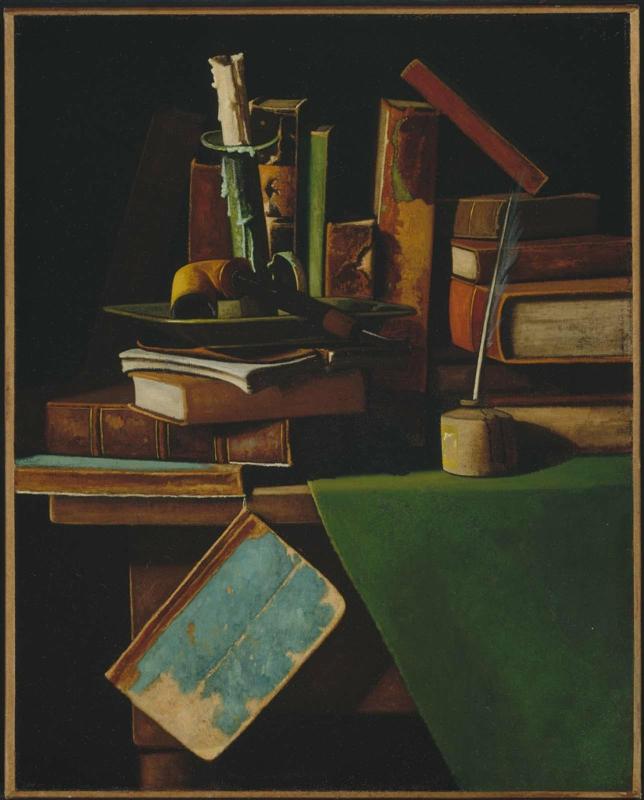Student's Materials
John Frederick Peto
(American, 1854–1907)
about 1890–1900
Medium/TechniqueOil on canvas
Dimensions51.75 x 41.59 cm (20 3/8 x 16 3/8 in.)
Credit LineBequest of Maxim Karolik
Accession number64.412
On View
Not on viewClassificationsPaintings
Collections
Peto's viewer has opened a doorway onto the dark corner of a private study. The initial impression is one of disorder. Books are stacked haphazardly, teetering near the corner of a simple, well-used table. An extinguished candle juts out of a wax-encrusted candlestick, which in turn sits precariously on top of an uneven pile of books and a pamphlet, open face down. A tobacco pipe is perched on the edge of the candlestick base. A ceramic inkwell rests on the green tablecloth, its label worn away. A few rivulets of dried ink stain its side. In the jar leans a frayed quill pen, a compositional counterbalance to the candle. Above it, a slim volume with a reddish-brown binding leans diagonally, its line echoed by the top and bottom edge of a book or journal at left that hangs rather curiously by a thread that, in turn, appears to be anchored to the table only by the weight of the stack of books above. This careless stacking of books, as if a scholar or student were lost in thought, suggests a disregard for material concerns and becomes an outward expression of intellectual reverie.The presence of the scholar is implied by his well-thumbed books, and by the pipe and quill pen--personal objects that are extensions of the scholar's hand. Both suggest traces of his existence: the smell of the pipe, the voice and hand of the author as transcribed in ink. Though the painting is purely visual, it suggests broader sensory stimulation. At the same time, these sensations have cased. By extension, the scholar is absent. The pipe and candle are extinguished; the pen is still. Contradiction lies at the core of this painting. The disarray of a chaotic heap of books that threatens to collapse upon itself stands in contrast to the orderly, precise nature of Peto's technique and, in fact, to the very conscientious effort he made to arrange and stack these materials just so. The unstudied, unplanned look of the still life is deliberate and intentional. Peto produced numerous compositions featuring similar elements, and often, identical objects, many of which can be found in period photos of the artist's studio. For all the apparent legibility of "Student's Materials"--it is cleanly and clearly painted to convey a sense of visual fidelity--the painting in fact withholds a great deal. The illusion of physicality, of materiality, dissolves readily into paint upon inspection. These books are closed to the viewer, withholding whatever information or knowledge they contain. Not a single legible word appears on the visible spines. Even the ink label has been obliterated. Suggestive and open to interpretation, the painting retains its inscrutability.Cody Hartley
InscriptionsUpper right: J F PetoProvenanceThe artist; probably Mrs. George Smiley, the artist's daughter, Island Heights, N.J., 1907; with Victor Spark, New York; to Maxim Karolik, Newport, R.I., 1953; to MFA, 1964, bequest of Maxim Karolik.
Peter Frederick Rothermel
about 1871













